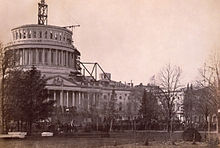25th Pennsylvania Infantry Regiment
Composed of Pennsylvania First Defenders, the first five companies of men who responded to President Lincoln's call for 75,000 volunteers to defend the national capital in Washington, D.C. following the Fall of Fort Sumter to Confederate States Army troops in mid-April 1861, and five additional companies of early responders who enlisted later in April 1861.
[2] In anticipation of the call by President Abraham Lincoln for volunteer troops to assist in the defense of the nation's capital following the firing on Fort Sumter by Confederate States forces on April 12, 1861, 476 officers and enlisted men from the communities of Allentown, Lewistown, Pottsville, and Reading, Pennsylvania, who were already active with existing militia units in those communities (the Allen Rifles of Allentown, Logan Guard of Lewiston, National Light Infantry and Washington Infantry of Pottsville, and Ringgold Light Artillery of Reading), began equipping themselves on April 13, and assembled in Harrisburg on April 17, two days after Lincoln issued his proclamation requesting the response of 75,000 volunteers.
After marching two miles to the Camden Station, they boarded a new train and headed for Washington, D.C., where they arrived at 6:00 p.m. Later given the honorific of "First Defenders" in recognition of their prompt action, they were initially stationed in various rooms of the United States House of Representatives and Senate before moving to the U.S. Capitol Building where, at 9:00 p.m. that same evening, they were issued new Springfield rifles and ammunition as Lincoln and key members of his cabinet looked on.
[3][4] These "First Defenders" were assigned to the regiment's various units as follows:[5][6] On the same day that these First Defenders were arriving in Washington, the remainder of the regiment, which would ultimately be designated as the 25th Pennsylvania Volunteer Infantry, was being organized in Harrisburg, Pennsylvania by Colonel Henry L. Cake, Lieutenant Colonel John B. Selheimer and Major James H. Campbell.
On July 1, they were ordered to Poolesville, from where they moved to Sandy Hook opposite Harper’s Ferry, at which point Colonel Cake resumed command.

